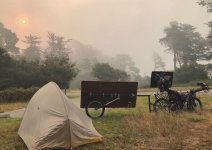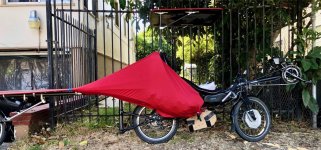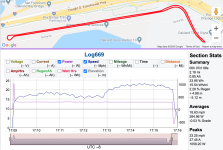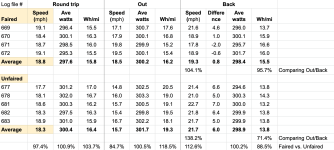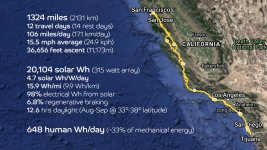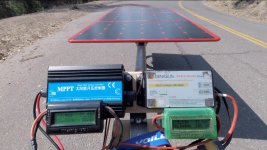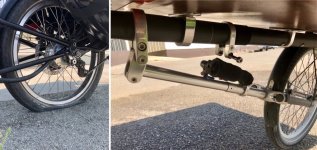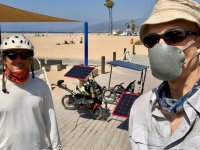I decided my wind gust problem was mostly hardware related. The adjustable driveshaft clutch I'm using to protect the tiny gearbox of the motorized tilt mechanism was not strong enough to hold the panel in place against a sudden wind gust. Even when the panel was level, a slight updraft could
suddenly flip the panel, which was dangerous at any speed.
A stronger clutch wouldn't fit inside the trailer tube so I explored a couple of externally-mounted solutions. The first is a solenoid-actuated locking mechanism. Effectively, a secondary clutch that would fit around the outside of the tube. The Arduino tilt motor controller would active the solenoid before each motor movement to pull apart the
Hirth joint and re-engage it afterward. The joint is spring-loaded so it remains locked when the solenoid is de-energized. I even got as far as ordering the parts for this one but didn't love the idea because I really wanted to keep the entire mechanism inside the tube for better dust/moisture protection and for better aesthetics. The second scheme below is a larger external motor with external gears but suffers from the same limitations.
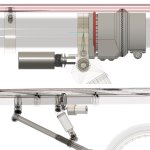
That's when I hit upon this bit of cleverness: I added a second planetary gearbox ("
Gearbox 2" below) on the other side of the clutch. An external force on the panel (wind gust, crash, manual tilt adjustment by hand) now goes through a 3.7:1 gearing change so the max torque of the clutch is effectively multiplied by 3.7. The tilt speed would have been reduced by 3.7 so I changed the
Gearbox 1/motor combo from a 5.2 RPM model (670:1 reduction) to a 9 RPM model (387:1 reduction). The maximum panel tilt speed is reduced but I have more torque to move the panel against a stiff breeze and the slower speed actually helps with small positioning adjustments. I'm driving the 12V brushed motor with a PWM controller but if I go slower than about 1/2 speed it doesn't have enough torque to move the panel and the motor will stall.

This new version has been rock solid for several hundred miles now. I was gifted the opportunity to crash test it on a recent overnight trip. This was a short, steep, loose grade. I had the wrong tires and wrong tire pressure for something like this (the trip was 90% paved roads and paths) and 2 wheel drive wasn't enough to overcome the challenge. I managed to come to a safe stop and dismount but dropped the bike when I tried to push it up the hill while applying throttle and the front wheel spun out. There's just not enough weight on the drive wheel in this situation.
I wonder if I set the Cycle Analyst to limit speed to something like 5 mph would that prevent the spin-out? Speed signal is via one of the motor hall sensors so I may not have enough rotational resolution to detect the slip?

Here's a close-up of the custom mounting brackets for the panels. There are two low-friction UHMW plastic brackets in front which are designed to slip where the panels connect to the stationary trailer tube and two solid metal brackets which clamp to the rotating tube section in the rear. I've found that polished 6061 alumin
ium holds up surprisingly well to corrosion. I have parts that still look brand new after 2 years of riding near salty sea air though they rarely get wet as it doesn't rain much here and the bike has been garaged at night. There's no clear coat and it scratches very easily. I'll experiment with anodizing in the future.

The timing of the current California wildfires was an inconvenience but I had a non-refundable reservation. I wore my 3M 6503QL respirator with P99 filters to deal with the smoke. The rubber pressed against my face all day isn't what I'd call comfortable but it's easier to breathe through than any cloth mask I've tried and is more effective at blocking particulates than N95 masks. I could still smell the smoke when I got to more heavily polluted areas.

The whole rig worked like a champ. I had it fully loaded with extra gear and water to approximate the weight I will need to carry on remote stretches. Total gross vehicle weight: 340 lbs (155 kg) including food, water, gear, rider, bike and trailer. I had to max out the rear shock at 275 psi to get a 35% preload but the bike handled it with ease. I'm very pleased.
Two-day trip used 440 Wh from the pre-charged battery and 2810 Wh from solar. I had energy to spare, covering 89 miles (143 km) with 800 meters of climbing per day and felt like I could have gone 50% farther.
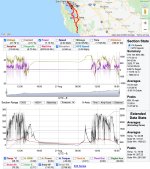 Fully interactive log file
Fully interactive log file.
